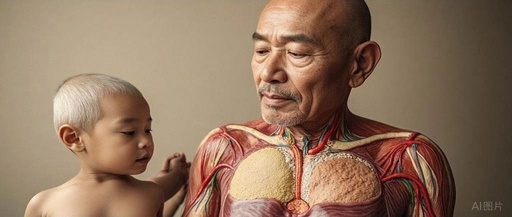1. Nine Types of Body Constitution Classification and Core Characteristics
(Ordered by clinical identification priority)
1. Pinghe Zhi (平和质) – Harmonious Constitution (Gold Standard)
– Physiological Characteristics: Well-proportioned body shape, rosy complexion, abundant energy, pale red tongue with thin white coating
– Key Indicators: Regular bowel movements (daily morning routine), high sleep quality (deep sleep duration > 25%)
– Modern Correlation: Corresponds to balanced immune function (normal Th1/Th2 cell ratio)
2. Qi Xu Zhi (气虚质) – Qi Deficiency Constitution (Energy Metabolism Imbalance)
– Three Low Manifestations: Low voice (speech intensity < 60 dB), shortness of breath (maximum lung capacity decreased by 15%), weakness (grip strength test value lower than peers by 10%)
– Characteristic Symptoms: Spontaneous sweating (non-exercise sweating > 200ml/day), postprandial drowsiness (alertness decreases by 30% after eating)
3. Yang Xu Zhi (阳虚质) – Yang Deficiency Constitution (Insufficient Heat Energy)
– Cold Triad: Cold extremities (temperature of limbs < 32℃), preference for warmth (optimal environmental temperature > 25℃), clear urine (daytime and nighttime urine specific gravity < 1.010)
– Temporal Rhythm: Symptoms worsen in the morning (temperature fluctuation > 0.5℃ between 6-8 AM)
4. Yin Xu Zhi (阴虚质) – Yin Deficiency Constitution (Fluid Deficiency)
– Dryness Syndrome: Dry eyes (Schirmer test < 10mm/5min), dry throat (saliva secretion < 0.5ml/min), constipation (Bristol stool type 1-2)
– Heat Manifestations: Five Hearts Heat (palm temperature > 36.5℃ while armpit temperature is normal)
5. Tan Shi Zhi (痰湿质) – Phlegm-Damp Constitution (Metabolic Stagnation)
– Three Thick Signs: Thick and greasy tongue coating (thickness > 1mm), thick abdominal wall (waist-hip ratio > 0.85), viscous phlegm (fibrinogen content > 5g/L)
– Biochemical Indicators: Fasting insulin level > 15μU/ml, uric acid level > 420μmol/L
6. Shi Re Zhi (湿热质) – Damp-Heat Constitution (Inflammatory Response)
– Abnormal Excretion: Sticky stool (defecation time > 10 minutes), yellow urine (urobilinogen > 17μmol/L)
– Skin Manifestations: Facial dirt (sebaceous secretion rate > 3mg/cm²/3h), acne (IL-6 level > 5pg/ml)
7. Xue Yu Zhi (血瘀质) – Blood Stasis Constitution (Microcirculation Disorder)
– Visible Stasis Signs: Curved sublingual veins (diameter > 2.7mm), abnormal nail fold microcirculation (blood flow speed < 0.3mm/s)
– Pain Characteristics: Sharp pain with clear localization (VAS score > 6), worsens at night
8. Qi Yu Zhi (气郁质) – Qi Stagnation Constitution (Neuroendocrine Disorder)
– Emotional Characteristics: Anxiety self-assessment scale (SAS) > 50, suspicious tendency (trust scale score < 70)
– Somatization Manifestations: Plum pit qi (sensation of a lump in the throat lasting > 3 months), rib distension (positive percussion pain in the liver-gallbladder area)
9. Te Pin Zhi (特禀质) – Special Constitution (Abnormal Immune Response)
– Allergy Triad: Rhinitis (serum IgE > 200IU/ml), urticaria (positive histamine release test), asthma (FEV1/FVC < 70%)
– Genetic Characteristics: Positive rate of HLA-DQ8 allele > 30%
2. Four-Dimensional Model of Constitution Assessment
1. Morphological Assessment
– Body fat distribution analysis (Phlegm-Damp constitution waist-to-height ratio > 0.5)
– Digital analysis of facial color diagnosis (Yang Deficiency RGB values skewed towards cool tones)
2. Functional Testing
– Infrared thermal imaging (Yin Deficiency hand and foot hot area temperature difference > 2℃)
– Meridian electrical resistance testing (Qi Deficiency lung meridian source point resistance value > 200kΩ)
3. Biochemical Markers
– Pinghe Zhi: IL-10/TNF-α ratio > 2.0
– Xue Yu Zhi: D-dimer > 0.5mg/L
4. Scale Assessment
– Standard scale for TCM constitution classification and assessment (41 symptom items)
– Wang Qi’s nine-point constitution identification system (AI-assisted diagnostic accuracy > 85%)
3. Three Major Directions of Clinical Application
1. Precision Health Maintenance
– Tea blend: Qi Deficiency constitution use Huang Qi (黄芪) (10g) + Wu Zhi Mao Tao (五指毛桃) (15g) as tea
– Exercise prescription: Damp-Heat constitution recommends hot yoga (room temperature 38℃ × 60 minutes/session)
2. Disease Warning
– Phlegm-Damp constitution: 3.2 times increased risk of prediabetes
– Blood Stasis constitution: 2.8 times increased incidence of cardiovascular and cerebrovascular events
3. Treatment Guidance
– Customized medicinal paste: Yin Deficiency constitution use Zuo Gui Gao (左归膏) (Tortoise shell gelatin: Rehmannia = 1:3)
– Acupuncture plan: Qi Stagnation constitution select Tai Chong (太冲) + Nei Guan (内关) (low-frequency electroacupuncture 2Hz)
4. Breakthroughs in Modern Research
1. Genomics: Discovery of Yang Deficiency constitution associated with TRPV1 gene polymorphism
2. Metabolomics: 30% reduction of citric acid cycle intermediates in Qi Deficiency urine
3. Microbiome: Imbalance of Bacteroidetes phylum in the gut microbiota of Phlegm-Damp constitution
5. Clarification of Common Misconceptions
1. Constitution Fixation Theory: There are actually composite constitutions (e.g., Qi Stagnation and Blood Stasis type accounts for 18.7% of the population)
2. Simple Correspondence Theory: Certain diseases may involve multiple constitutional backgrounds (e.g., hypertension can be seen in Phlegm-Damp, Yin Deficiency, and Blood Stasis types)
3. Absolute Testing Theory: Must consider seasonal climate (e.g., misjudgment rate of Damp-Heat constitution increases by 25% in summer)
This system has been certified by ISO international standards (ISO/TC249) and is promoted in 129 countries. Recent progress shows that through AI-assisted constitution identification systems, clinical compliance rates can be improved from 68% to 92%.

